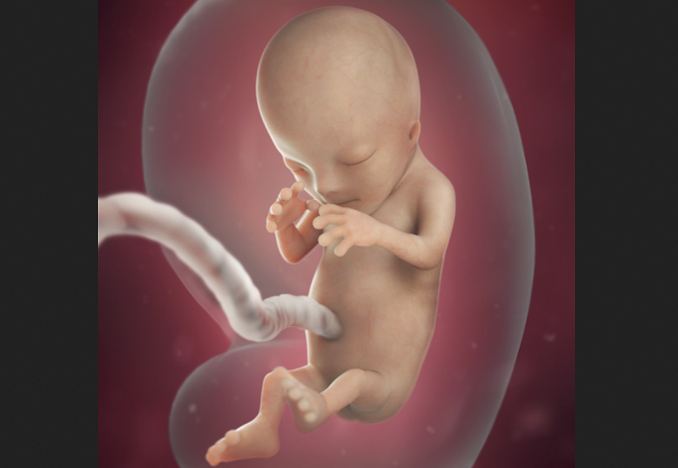- There is a functional, beating heart in every human being by 6 weeks of gestation[1]
- The heart is the embryo’s first functioning organ, which starts to develop as early as 16 days after fertilization.[2]
- The first heartbeat occurs approximately day 22-23 after fertilization, which is 5 weeks and 1-2 days of gestation.[3]
- The heart forms very early in embryogenesis because the embryo’s survival requires circulation of oxygen-carrying blood, a fact that is validated by all embryology textbooks.
- The fetal heart is a vital source for oxygen and nutrient distribution, because passive oxygen diffusion that sustains the embryo earlier in gestation becomes insufficient to support the embryo’s continued existence.[4]
- Initially, the embryonic heart rate is, on average, 110 beats per minute,[5] and increases to approximately 170 beats per minute at 9-10 weeks of gestation.[6]
- Even at this early stage, the heart has primitive heart valves that act as physical barriers that prevent the backflow of blood through the heart tube and assist in the forward propulsion of blood as it is pumped through the heart and out through the rest of the body.[7]
- The embryonic heartbeat can be detected at 6 weeks of gestation
Follow LifeNews.com on Instagram for pro-life pictures and videos.
- At 6 weeks of gestation, the heartbeat can usually be detected via a transvaginal ultrasound.[8]
- The early embryonic heartbeat is best detected using doppler ultrasonography. This measures the movement of the beating heart. Ultrasonography does not measure electrical activity, it measures pulses of high-frequency sound reflected off solid objects.
- At 6 weeks, the embryo’s heart is beating rhythmically, and the heart can be easily identified. A video of the embryonic heart’s movement has been captured for viewers to see.[9]
- Researchers have found that the presence of a heartbeat at 6-8 weeks indicates that the baby has a very high chance of surviving to childbirth.[10]
[1] There are two common systems for denoting an embryo’s prenatal age. Weeks of fertilization or conception refers to the beginning of human life at pregnancy. Weeks of gestation refers to pregnancy based on the woman’s last menstrual period, in which the number of weeks referenced is typically 2 weeks greater than fertilization age (e.g., a human embryo is 0 weeks old at fertilization, which is 2 weeks of gestation). Unless specifically noted, the age is given in gestation weeks. See Charlotte Lozier Institute, “The Voyage of Life: Weeks 1 and 2,” Charlotte Lozier Institute, accessed July 30, 2025, https://lozierinstitute.org/fetal-development/weeks-1-and-2/.
[2] Benjamin Kloesel et al., “Cardiac Embryology and Molecular Mechanisms of Congenital Heart Disease – A Primer for Anesthesiologists,” Anesthesia and Analgesia 123, no. 3 (2016): 551–69, https://doi.org/10.1213/ANE.0000000000001451.
[3] S. Britten et al., “Pregnancy: Very Early (24–56 Days from Last Menstrual Period) Embryonic Heart Rate in Normal Pregnancies,” Human Reproduction 9, no. 12 (1994): 2424–26, https://doi.org/10.1093/oxfordjournals.humrep.a138462; Cheryl Mei Jun Tan and Adam James Lewandowski, “The Transitional Heart: From Early Embryonic and Fetal Development to Neonatal Life,” Fetal Diagnosis and Therapy 47, no. 5 (2020): 373–86, https://doi.org/10.1159/000501906.
[4] Tan and Lewandowski, “The Transitional Heart.”
[5] P. M. Doubilet and C. B. Benson, “Embryonic Heart Rate in the Early First Trimester: What Rate Is Normal?,” Journal of Ultrasound in Medicine 14, no. 6 (1995): 431–34, https://doi.org/10.7863/jum.1995.14.6.431.
[6] George I. Papaioannou et al., “Normal Ranges of Embryonic Length, Embryonic Heart Rate, Gestational Sac Diameter and Yolk Sac Diameter at 6-10 Weeks,” Fetal Diagnosis and Therapy 28, no. 4 (2010): 207–19, https://doi.org/10.1159/000319589.
[7] Michelle D. Combs and Katherine E. Yutzey, “Heart Valve Development,” Circulation Research 105, no. 5 (2009): 408–21, https://doi.org/10.1161/CIRCRESAHA.109.201566; Bruce M. Carlson, “Development of the Heart,” in Reference Module in Biomedical Sciences (Elsevier, 2014), https://doi.org/10.1016/B978-0-12-801238-3.05460-X.
[8] Peter M. Doubilet and Carol B. Benson, “Outcome of First-Trimester Pregnancies with Slow Embryonic Heart Rate at 6–7 Weeks Gestation and Normal Heart Rate by 8 Weeks at US,” Radiology 236, no. 2 (2005): 643–46, https://doi.org/10.1148/radiol.2362040880.
[9] “The Heart in Action,” The Endowment for Human Development, accessed July 30, 2025, https://www.ehd.org/movies.php?mov_id=21.
[10] Jennifer S. Hyer et al., “Predictive Value of the Presence of an Embryonic Heartbeat for Live Birth: Comparison of Women with and without Recurrent Pregnancy Loss,” Fertility and Sterility 82, no. 5 (2004): 1369–73, https://doi.org/10.1016/j.fertnstert.2004.03.058.
LifeNews Note: Reprinted from the Charlotte Lozier Institute.
The post Unborn Baby’s Heart Starts Beating 22 Days After Conception appeared first on LifeNews.com.
Click this link for the original source of this article.
Author: Charlotte Lozier Institute
This content is courtesy of, and owned and copyrighted by, https://www.lifenews.com and its author. This content is made available by use of the public RSS feed offered by the host site and is used for educational purposes only. If you are the author or represent the host site and would like this content removed now and in the future, please contact USSANews.com using the email address in the Contact page found in the website menu.








